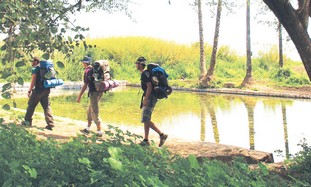Minister of Tourism Stas Misezhnikov inaugurated on Tuesday the new Gospel Trail pilgrimage route which has been created by the Ministry of Tourism along with the Jewish National Fund.

The trail, which cost NIS 3 million to develop over three years, is designed to further increase the already large numbers of Christian tourists and pilgrims who visit Israel each year.
The ministry will now embark on a marketing campaign to promote the new pilgrimage route.
“We are creating a revolution in tourism to Israel,” Miszensikov said at the foot of Mount Arbel by the Kinneret. “In recent years we looked at which target audience we could work with, and we decided that first and foremost is the Christian world. So it is a real honor to invite the entire Christian world to follow in the footsteps of Jesus and to walk in the same places where he walked.”
According to the Ministry of Tourism, 2010 was a record year for tourism, with nearly three-and-ahalf million visitors arriving in the country. Of those, approximately 66 percent were Christians, and of the total number of tourists, 30%, or approximately 1 million, came explicitly for the purposes of a pilgrimage or spiritual journey.
Miszensikov said that he expects the Gospel Trail to attract an additional 200,000 tourists every year above the current figures.
The route of the Gospel Trail follows the path which Jesus walked at age 30 after he was evicted from Nazareth, as related by the New Testament.
The trail, which runs for 63 kilometers, starts at Mount Precipice just outside Nazareth and continues eastwards down to Capernaum, taking in a number of important Christian holy sites.
These include the Mount of Beatitudes, where Jesus gave the Sermon on the Mount; Magdala (Migdal today) the home of Mary Magadelene; Tabgha, the site of the Feeding of the Five Thousand; and Capernaum, where Jesus established his ministry and met his first disciple Peter.
Those traveling the trail will be able to do so by car, bicycle and, more traditionally, on foot – despite the current lack of amenities and accommodation along the route. The ministry says it is working on a program to encourage entrepreneurs to develop tourist facilities to provide services for those walking the trail.
Father Juan Maria Solana – the head of the Catholic Notre Dame Center in Jerusalem and director of the Magdala center, which cooperated with the Ministry of Tourism in creating the trail – explained to the assembled crowd the importance of the new trail.
“I spent some time in Spain and walked the Santiago trail there,” he said. “So when I came to the Holy Land, I asked myself ‘how is it possible that there is not a walking path to walk in the footsteps of Jesus Christ?’ so I am extremely happy now that the Gospel Trail has been completed, which will enable many Christians around the world to follow in his footsteps.”
Solana also refuted any suggestion that the new initiative was in any way exploitative of Christian pilgrims.
“The Tourism Ministry wants to promote tourism, for sure, but there is also a sincere and genuine desire to develop the region for Christian pilgrims so they can experience the religious history and culture here, so everyone can benefit,” said Solana. “And it’s very important for Christians to come here. It’s like the transition from a black-and-white TV to a plasma screen. To really understand the scriptures, you have to come here and see the places mentioned in the Bible, and experience the land in which Jesus walked.”
Misensikov echoed this sentiment: “Israel invests a lot of money in renovating and safe-guarding the holy places of all religions here. Is it problematic to also use the culture and history of the area to promote pilgrimage and tourism for the benefit of all nations? I don’t think so.”
The Tourism Ministry wants to increase the total number of visitors to the country to 5 million people by 2014, therefore the Christian world is, in Miszensikov’s words, one the ministry’s “main target audiences” to achieve this goal.
Among some of the countries with big potential for increased Christian tourism are Indonesia and India. According to ministry statistics, in 2010 more than 20,000 Christian tourists from Indonesia came to Israel – which has a total Christian population of approximately 23 million – despite the fact that the two countries do not enjoy formal diplomatic relations.
There were also 40,000 tourists from India, 75% percent of whom were Christians, and the ministry sees the subcontinent as another potential tourism market, with its community of approximately 24 million Christians.
Author: Jeremy Sharon | Source: The Jerusalem Post [November 30, 2011]